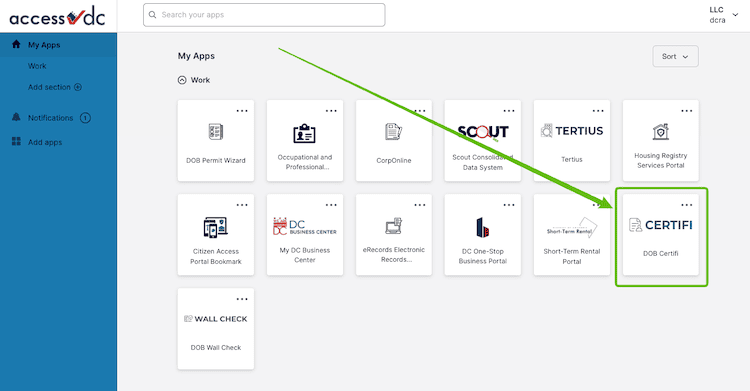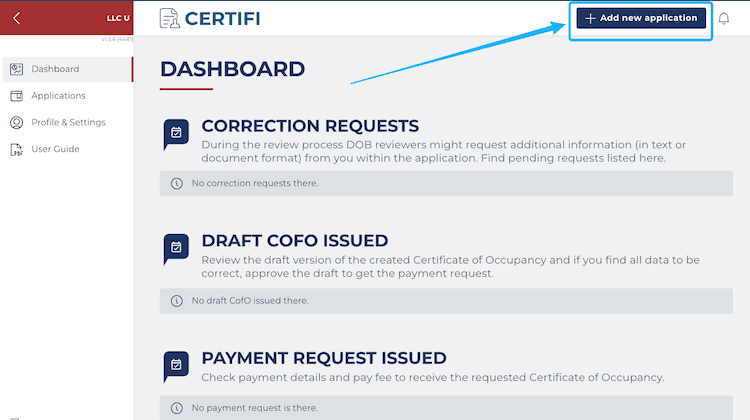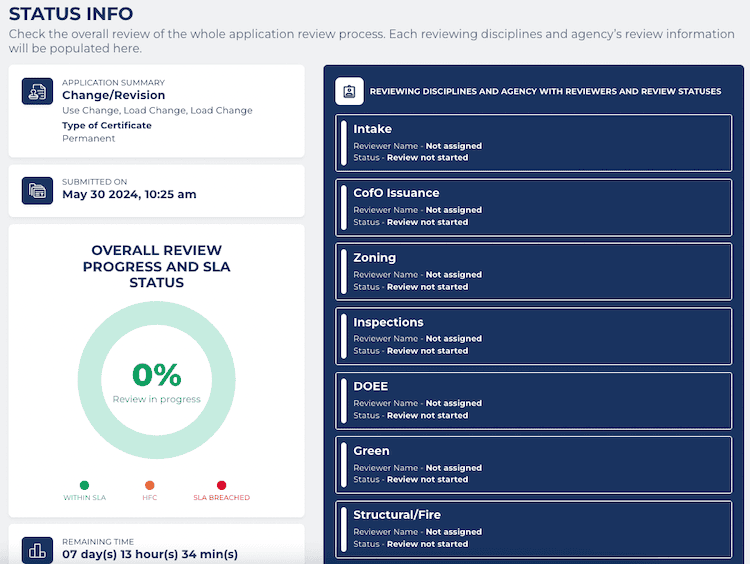Deal alert! Northwest will form your LLC for $39 (60% discount). See details.
Certificate of Occupancy for LLCs in the District of Columbia
Your DC LLC needs a Certificate of Occupancy if you own or lease commercial/office space in the District of Columbia.
Additionally, if you’re developing new construction, you’ll also need to apply for a Certificate of Occupancy.
If you’re renting office space, it’s likely that the building’s Certificate of Occupancy will cover your business activities. If that’s the case, you’ll need the building’s Certificate of Occupancy Number in order to enter it into your Basic Business License Application (which we’ll discuss in the next lesson).
However, if the building doesn’t have a Certificate of Occupancy (or their Certificate of Occupancy doesn’t cover your business activities), then you’ll need to apply for your own Certificate of Occupancy.
If you own (or recently purchased) a commercial/office space and will be doing business there, then you’ll need a Certificate of Occupancy.
Note: If you rent or own your home and want to run your business from home, then you need a Home Occupation Permit instead of a Certificate of Occupancy.
What is a Certificate of Occupancy (C of O)?
A Certificate of Occupancy (C of O) is a document showing that a specific building, structure, or piece of land is being used in a manner that is in accordance with Title 11 (Zoning Regulations) of the District of Columbia Municipal Regulations (DCMR) as well as in accordance with the DC Building Codes (Title 6, 12, 14, and 42).
Note: The Department of Consumer and Regulatory Affairs (DCRA) used to administer the Certificate of Occupancy. In October 2022, the Department of Buildings took over the Certificate of Occupancy program.
What is the purpose of a Certificate of Occupancy?
While all these rules and regulations may seem complicated, they, and the issuance of Certificates of Occupancy, have one primary purpose: to keep the people who live and work in DC safe.
No one can use a building, structure, or piece of land in the District (other than single-family homes) unless a Certificate of Occupancy has been issued by the Department of Buildings.
Will you be leasing space?
If you are leasing space within a building that already has a Certificate of Occupancy, you don’t need to get a Certificate of Occupancy as long as the building’s Certificate of Occupancy allows for your intended use.
For example: If you run a marketing agency and rent office space within a large office building, it’s very likely that your business activities will be covered under the building’s existing Certificate of Occupancy.
However, if your building’s Certificate of Occupancy doesn’t allow for what your business does, then you’ll need to apply for your own.
For example: You have a small lab that tests and manufactures skin care products. Due to the risk of certain substances that may be in your office, you may need your own Certificate of Occupancy as the building’s Certificate of Occupancy doesn’t cover this type of business activity.
Furthermore, if the building you are occupying doesn’t have a Certificate of Occupancy, then you will need to apply for one before you can begin operating your business.
Get the Certificate of Occupancy Number
When applying for your LLC’s Basic Business License, you will need to enter your building’s Certificate of Occupancy Number.
Get a copy of the Certificate of Occupancy from the owner or property management company.
You should also be able to find the Certificate of Occupancy Number fairly easily as it’s a requirement that a building prominently display their Certificate of Occupancy. It’s usually close to the entrance or main reception desk.
Recommendation:
Speak with your leasing agent or the building owner about the building’s Certificate of Occupancy before renting any space in the District.
How much does a Certificate of Occupancy cost?
If you need to apply for a Certificate of Occupancy, the total cost will be based on square footage of the building.
All Certificate of Occupancy applicants will pay a $36.30 application fee. The final fee (the issuance fee) will vary depending on the building’s square footage. On average, the total is somewhere between $75 to $125.
The 6 Types of Certificates of Occupancy
There are 6 different types of Certificates of Occupancy applications:
- change of ownership
- change of use
- change of occupant load
- revision
- temporary occupancy
- new building (completion of core and shell, conditional, and establishment of a new occupancy)
Change of Ownership
A Change of Ownership Certificate of Occupancy is used after a building has been purchased by a new owner. It is the most straightforward Certificate of Occupancy application among the 6 (since the existing building likely already has a Certificate of Occupancy).
Change of Use
A Change of Use Certificate of Occupancy is used when the purpose and use of the building or structure is changing. For example, you plan to open a yoga studio where a pet grooming business used to be located.
Change of Occupant Load
A Change of Occupant Load Certificate of Occupancy is when the owners propose to change the number of occupants (the “load”) in a given building.
For example: Seating capacity in a restaurant, number of occupants in a boarding/community home, number of classrooms or number of students in an educational facility, increasing the number of units in a hotel, motel, or apartment building, and other similar changes. Depending on the circumstances, a Building Permit may also be required.
5,000 square feet +
If you’re proposing to change the occupant load in a building that is 5,000 square feet or larger, your proposed changes must be reviewed and approved by the District Department of the Environment (DDOE) Stormwater Management. If you don’t request a final inspection of your stormwater management system as well as your plans/drawings, this will likely result in you being denied your Certificate of Occupancy.
Revision
A Revision of a Certificate of Occupancy is used when an error was made on the original issued Certificate of Occupancy. There can be no substantial changes to the use or occupancy as allowed by the original issued Certificate of Occupancy.
Temporary Occupancy
A Certificate of Occupancy for Temporary Occupancy (aka “Temporary/Seasonal C of O”) is usually used for an outdoor event or use of a building on a limited/temporary basis. The Department of Buildings may also impose certain conditions to be met for the safety of the attendees. Depending on the type of use of the building, a Building Permit may also be required prior to the Department of Buildings issuing the Certificate of Occupancy.
New Building (“Completion of Core and Shell”)
A Completion of Core and Shell Certificate of Occupancy is not a “full” Certificate of Occupancy and it doesn’t mean the building can be occupied. It’s simply recognizing that the core and shell of the building have been completed in accordance with the DC Building Codes. This type of Certificate of Occupancy is required in order to get a Conditional Certificate of Occupancy for a new building.
New Building (“Conditional”)
A Conditional Certificate of Occupancy may be issued by the Department of Buildings to allow certain occupancy of the building while the rest of the building/construction is taking place. A Completion of Core and Shell Certificate of Occupancy must be issued before a Conditional Certificate of Occupancy can be issued.
New Building (“Establishment of a New Occupancy”)
This is the “final” Certificate of Occupancy that’s issued by the Department of Buildings once a new building has been completed and is ready to be occupied. Inspections must be scheduled before the final Establishment of New Occupancy Certificate of Occupancy can be issued.
5,000 square feet +
If your new building will be 5,000 square feet or more, you must request an inspection by the District Department of the Environment (DDOE) Stormwater Management. They need to do a final inspection of your building’s stormwater management system and your plans/drawings. If you don’t request this inspection, you’ll likely be denied your Certificate of Occupancy.
How to apply for a Certificate of Occupancy
Note: The C of O application process has gone through several revisions in the past few years. In 2024, everything was streamlined into one online application process. No more filing paper forms by mail, and no more sending applications via email.
We specialize in LLC formation in all 50 states; not zoning regulations in DC. Therefore, the information provided in this lesson is more of an overview and it’s meant to point you in the right direction instead of walking you through everything step-by-step.
Call the Department of Buildings for Help
We recommend reading this guide so you understand the Certificate of Occupancy requirements. And then, call the Department of Buildings to speak with a representative, develop a plan of action, and make sure you know exactly what documents and approvals you will need.
This is the best way to avoid surprises, or worse, having your Certificate of Occupancy Application denied.
You can call the Department of Buildings at 202-671-3500 (Press 3 for Permits) or use their online chat service.
Applying for a Certificate of Occupancy
DC Certificate of Occupancy applications are filed through Certifi, an online filing portal at the DC Department of Buildings.
You will need an Access DC login to use Certifi. To access Certifi from your Access DC dashboard, just look for the DOB Certifi button:

Once you’re in the Certifi system, click the button for “+ Add New Application” on the top of the screen.

Property Address
Enter your address, then click Search.
Property Owner Validation
Select the correct property (including the correct unit/apartment).
Click Save and Continue to proceed.
Applicant Validation
Tell the system whether you own the property.
- If you own the business space, select Property Owner.
- If you rent or lease it, select Business Owner/Tenant.
Accept the disclaimer and terms.
Property Owner Contact Information
Enter the landlord (or property owner’s) contact information.
Note: This field only appears if you select Business Owner/Tenant above.
Applicant Contact Information
Enter your contact information here. Put your LLC’s name in “Trade Name”.
Enter your address. It’s okay if this is the same as the address you’re getting the C of O for.
Secondary Contact
You can add a secondary contact here. This could be a business associate who can answer questions about the business.
Click Save and Continue to proceed.
Existing CofO
Select “There is no valid Certificate of Occupancy” if you are doing:
- Temporary/Seasonal
- New Construction
- New Tenant Buildout
- Major Renovation of an existing space/building that may have been previously occupied.
Wait! If there is no existing C of O for the property, you must stop here and get a permit. You can’t continue with this Certificate of Occupancy filing until you get a Permit (and its Final Inspection), because you’ll have to link the permit and inspection to the Certifi system C of O process.
First, use the DOB Permit Wizard to apply for a permit. Once the permit is approved, you can go to Tertius, scroll down, and click “Begin Now” set up an inspection.
Select “There is a valid Certificate of Occupancy” only if you are doing a change/revision such as:
- change of ownership
- change of existing use, or
- change of occupant load.
If the existing C of O was issued after September 2008, you can search the DOB database to find the most recent C of O and link it to your application. In the Permit step, you’ll select the Permit that was filed for that C of O.
If the existing C of O was issued before 2008, you’ll use the eRecords database to find the most recent C of O. Then you’ll download it from eRecords and upload it into Certifi at a later step, with your other documents. In the Permit step, you’ll select the Permit that was filed for that C of O.
Select One Option
The options shown here will change, depending on what you selected above. Choose the one that matches your C of O type.
Click Save and Continue to proceed.
Building Description
Complete the fields to describe the building and your business. Some of these details might be available in your rental agreement, or from your property manager, or on your permit.
P.S. You can always call the Department of Buildings for help finding this information.
Existing Building/Space Owner
This means you, the business owner. This doesn’t mean your landlord or the company that owns a building that you rent a space in. This is asking about you (Owner) and your LLC (Business Trade Name).
If you’re applying for a C of O for a Change (Change of Ownership, Change in Use, Change in Occupancy Load), you’ll provide this information:
- Existing Conditions of the Building/Spaces
- Existing Use of Building/Space
- Existing Occupant Load of Building/Space
- Select the type of Proposed Changes (Owner, Use, Load) and then
- Proposed Building/Space Owner, if applicable
- Proposed Use of Building/Space, if applicable
- Proposed Occupant Load of Building/Space, if applicable
If you’re applying for a C of O for a New Construction/Establishment or a Temporary C of O, you’ll be asked for this information:
- Proposed Conditions of the Building/Spaces
- Proposed Use of Building/Space
- Proposed Occupancy Load of Building/Space
Click Save and Continue to proceed.
Permits
Type of Certificate of Occupancy
Choose whether you want a Permanent (most common) or Conditional (rare) Certificate of Occupancy. Most people choose Permanent.
Issued Building Permits
The system will help you search for any existing building permits for the address. Find the one with a date/description matching the last issued C of O.
Click Check Inspection Results, and the system will verify the permit and inspection.
Site Contact Information
Provide contact information for someone on-site in case the DOB wants to schedule additional inspections.
Click Save and Continue to proceed.
Summary and Submission
Click each section to expand it. Review the information you entered. Then, upload documents as needed.
Uploading Documents
You’ll see a number after the section titles – this tells you how many documents you need to upload for that section.
For example: (0/1) means you still need to upload 1 document in that section. (0) means you still need to upload some documents – it might be just one, but you might need to upload additional items.
Under the heading “Upload the following document(s)” in each section, the system tells you what document type is required.
For help figuring out what documents to upload, go to the Certificate of Occupancy Information page. Look for the section called “Documents Required for Complete Submission of your Application”. This helps you identify all the attachments you’ll need to upload.
Certification
Click to agree that your application is truthful.
Inspection Date
Select a date when the DOB can come do an inspection of your business space.
Check your email for details about the inspection scheduling.
Process and Review Timeframes
Read the instructions, and then click to agree to the terms.
Approval Process
After you submit your C of O application, the Certifi dashboard will show you how it’s progressing.
Here’s what it looks like right after you submit:

The DOB will review your application, and once the inspections are complete, the C of O will be approved. Then you’ll pay the fee(s) and obtain your final Certificate of Occupancy.
Contact Info: Department of Buildings
If you have any questions about getting a Certificate of Occupancy for your LLC, you can contact the Department of Buildings at 202-671-3500.
They also have a customer service chat feature on the Department of Buildings website. Click the speech bubble logo at the bottom right of any page.
The DOB’s hours are 8:30am to 4:30pm on Monday, Tuesday, Wednesday, and Friday. On Thursday their hours are 9:30am to 4:30pm.
DC Certificate of Occupancy FAQs
Do I need a Certificate of Occupancy for a residential building?
A Certificate of Occupancy is needed for residentially-zoned buildings that are multi-family dwellings (duplex, triplex, etc.), child development homes, bed & breakfasts, group homes, and other similar dwellings.
If you plan to use your home for another type of business purpose, then you must apply for a Home Occupation Permit instead. If you’re not eligible for a Home Occupation Permit, then you can’t operate your proposed business from your DC home. You must rent office space instead.
Do I need a Certificate of Occupancy if my business is a tenant in an office building?
Probably not. You don’t need to apply for your own Certificate of Occupancy if the existing owner:
- has a Certificate of Occupancy, and
- that Certificate of Occupancy allows for your business to operate in the space.
If neither 1 nor 2 are true, you must apply for your own Certificate of Occupancy.
I already have a Certificate of Occupancy. I want to renovate. Do I need a new Certificate of Occupancy?
You don’t need a new Certificate of Occupancy if all of these are true:
- you only renovate the interior (not the exterior)
- you don’t change the layout
- you don’t change the amount of square footage
- you don’t change the use
- you don’t change the occupant load
- the ownership of the building hasn’t changed
You need a new Certificate of Occupancy if any of these are true:
- you are renovating the exterior
- you change the layout
- you change the amount of square footage
- you change the use
- you change the occupant load
- the ownership of the building has changed hands
Is a Certificate of Occupancy a license to conduct business?
No, a Certificate of Occupancy isn’t a license granting you permission to conduct certain business activities.
It just certifies that your building is safe to be occupied and it meets the zoning codes.
Permission to conduct business activities in the District of Columbia is granted via a Basic Business License.
Can I get a Certificate of Occupancy for a temporary pop-up in a vacant building?
Yes. The new Pop-up Permits program can get you a Certificate of Occupancy in just 15 days, if you’re setting up a temporary “pop up” style business in a vacant building.
Read the DOB’s Pop Up Permits page for more information.
For more Frequently Asked Questions about Certificates of Occupancy:
The Department of Buildings has Zoning FAQs and a Certificate of Occupancy Guide to help.
References
DOB: Zoning FAQs
DOB: DC Construction Codes
DC Office of Zoning: Title 11 Zoning
DC Office of Zoning: Zoning Regulations of 2016
DOB: Conditional Certificate of Occupancy Issuance
DOB: Certificate of Occupancy Application and Review Process
DLCP: Certificate of Occupancy/Home Occupation Permit Details
DOB: Certificate of Occupancy Eating Establishment Questionnaire
DC Municipal Regulations and DC Register: Zoning Regulations of 2016

Matt holds a Bachelor's Degree in business from Drexel University with a concentration in business law. He performs extensive research and analysis to convert state laws into simple instructions anyone can follow to form their LLC - all for free! Read more about Matt Horwitz and LLC University.
District of Columbia LLC Guide
Looking for an overview? See District of Columbia LLC
Loved the clarity on Certificates of Occupancy. It’s great to see the intricacies broken down so well! I’m diving into real estate and find this info about the DC LLC requirements really insightful.
A couple of questions—since it seems like leasing a commercial space may not always require a separate Certificate of Occupancy if it’s covered under the building’s existing one, is there a specific way we should check if our business activities are eligible?
Also, considering some recent ownership changes and potential plans for new developments, do these processes apply uniformly throughout the DC area, or are there certain neighborhoods with different requirements?
Really appreciate the detailed guidance and would love to hear your insights. Thanks in advance for fostering such an informative discussion! Looking forward to learning more.
Hi Camille, you’re very welcome! To see if your activities are covered, I recommend getting the Certificate of Occupancy Number of the building, and then call the Department of Buildings to check. And great question re: if these processes apply uniformly throughout DC, but I’m actually not sure about that. Thank you very much for your kind words, Camille. I really appreciate it!
Hi there,
I’m planning on starting an online business. I’ll be subscribing to TravelingMailbox for my virtual mailbox, I’ll list myself as my own Registered Agent, and I’ll be living an an apartment in DC.
Would I need a certificate of occupancy in this situation? TravelingMailbox has said they don’t provide that.
Hi Eric, in order to get a Basic Business License in DC, either a Certificate of Occupancy or a Home Occupation Permit is required.
So I could do a Home Occupancy Permit with my home address (which isn’t my business address)?
Hi Eric, if you’re going to be running the business from home, then yes, you can get a Home Occupation Permit.
Hi, I am purchasing an apartment that has a temporary certificate of occupancy in DC for an apartment building that is renovated fully inside – 8 units. My bank has informed us that we can close if we want with the certificate they are provided. Can we close and move into the apartment with a temporary certificate of occupancy?
Thank you!
Norma
Hi Norma, we cannot say for sure if this is a good idea. While the bank may let you close, you may not want to take title to a building you can’t permanently occupy. A Certificate of Occupancy for Temporary Occupancy is just that; it’s temporary. It’s not the “final” Certificate of Occupancy so you may not be able to occupy the building. We cannot say for sure. We recommend reading over the section above titled “The 6 Types of Certificates of Occupancy” and calling the Office of the Zoning Administrator for details on the building’s COO. Hope that helps.